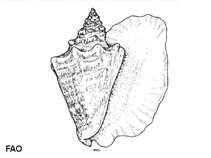Aliger gigas (Linnaeus, 1758)
Pink conch
Classification / Names Common names | Synonyms | CoL | ITIS | WoRMS
Gastropoda | Littorinimorpha | Strombidae
Environment: milieu / climate zone / depth range / distribution range Ecology
Benthic; depth range 2 - 73 m (Ref. 83934), usually ? - 30 m (Ref. 97646). Tropical; 33°N - 2°S, 97°W - 45°W
Distribution Countries | FAO areas | Ecosystems | Occurrences | Introductions
Western Atlantic: South Carolina to Brazil.
Length at first maturity / Size / Weight / Age
Maturity: Lm ?, range 2 - ? cm Max length : 30.0 cm SHL male/unsexed; (Ref. 105315); max. published weight: 3.3 kg (Ref. 105296); max. reported age: 30 years (Ref. 126618)
Short description Morphology
Shell large, with relatively large spire, flared outer lip with posterior expansion projecting well beyond spire length. Spire taller than other species in genus. Sculpture of sharp knobs along shoulder. Colour: pale tan with thin brown periostracum. Internal shell colour deep pink.
The fisheries have grown exponentially in the last 30 years, with resulting declines in population and area closures. The species has been included on appendix 2 of CITES (Convention on the International Trade of Endangered Species). International trade is allowed only from nations in which the populations of the species are not under threat from commercial fishing (Ref. 355). Maximum weight from Ref. 97674 cited in Ref. 105296.
Life cycle and mating behavior Maturity | Reproduction | Spawning | Eggs | Fecundity | Larvae
Copulation may precede spawning. Spawning occurs on a type of calcareous sand formed from the fragmentation of coral reefs, including large quantities of calcareous skeletal remains from small molluscs and calcareous algae. Females deposit the egg mass on the substrate (Ref. 105320). Life cycle: Eggs hatch into veligers after 3-5 days which feed on phytoplankton; after 21 days they undergo metamorphosis (juvenile stage) where they remain buried in the sand and emerge in seagrass beds to feed; adults return to the shallow inshore waters to spawn.
Main reference
References | Coordinator | Collaborators
Leal, J.H. 2003. (Ref. 355)
IUCN Red List Status (Ref. 130435: Version 2024-1)
CITES status (Ref. 108899)
Appendix II: International trade monitored
CMS (Ref. 116361)
Not Evaluated
Threat to humans
Human uses
Fisheries: highly commercial
| FIRMS (Stock assessments) | FishSource | Sea Around Us
Tools
More information
Trophic Ecology
Ecology
Population dynamics
Life cycle
Distribution
Human Related
Aquaculture profile
Stamps, Coins Misc.
Stamps, Coins Misc.
Outreach
References
Internet sources
Alien/Invasive Species database | BHL | BOLD Systems | CISTI | DiscoverLife | FAO(Publication : search) | Fishipedia | GenBank (genome, nucleotide) | GloBI | Gomexsi | Google Books | Google Scholar | Google | PubMed | Tree of Life | Wikipedia (Go, Search) | Zoological Record
Estimates based on models
Preferred temperature
(Ref. 115969): 25.3 - 28, mean 27 (based on 146 cells).
Resilience
(Ref. 69278):
Medium, minimum population doubling time 1.4 - 4.4 years (K=0.25-0.71; tm=3-4; tmax=30).
Prior r = 0.97, 95% CL = 0.64 - 1.45, Based on 4 data-limited stock assessments.
Nutrients : Calcium = 126 [75, 177] mg/100g; Iron = 4.79 [1.67, 7.92] mg/100g; Protein = 15.9 [14.8, 16.9] %; Omega3 = 0.331 [0.263, 0.400] g/100g; Selenium = 57.8 [48.5, 67.2] μg/100g; VitaminA = 0 μg/100g; Zinc = 1.97 [0.92, 3.02] mg/100g (wet weight); based on nutrient studies.



